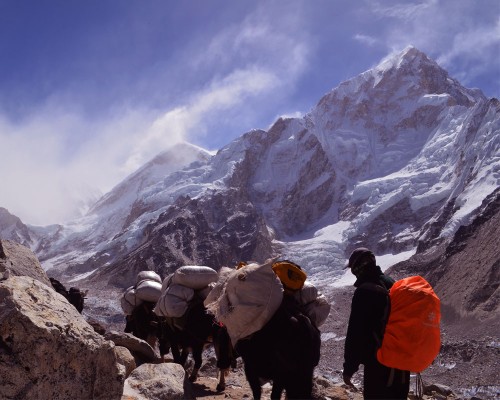The Everest Three Passes Trek is one of the most challenging hiking expeditions in the Everest Region. This is due to high-altitude trekking through the major passes namely; Kongma La, Cho La, and Renjo La.
You will cross these high-altitude passes each more challenging than the other. Not just that but you will also get to reach the EBC along with Kalapatthar.
Trekking this route will take you to scenic viewpoints, challenging trail climbs, and the Sherpa settlements with warm hospitality. Additionally, this trail covers almost all of the Khumbu Region Hikings.
This 17-day trekking journey has all the thrills you’d expect and then some more.
Among the 3 high passes, we start with the Kongma La Pass and continue to the base camp, Kala Patthar, Cho La Pass, Gokyo Ri, and finally, Renjo La Pass. You will have the privilege of watching the mightiest mountains like Everest, Lhotse, Nuptse, Cho Oyu, Makalu, and more from multiple angles and vantage points.
The beauty of the three-pass trek is that it combines the Gokyo Lakes trek, the classic Everest base camp trek, and Chukhung Ri peak climbing. You will spend over a week above the altitude of 4000 meters and crossing 5000 meters becomes a daily task.
What can I expect from the Everest Three Passes Trek?
This wider range of hike starts from Lukla alongside the lush rhododendron forests and Dudhkoshi River. The walk starts instantly when you land at the World’s most mysterious airport; the Lukla Airport itself. The vegetation keeps getting sparser as we ascend, and the trail starts getting rockier and icier.
The trail begins with flatter terrain and even goes downhill on the first day while you hike from Lukla to Phakding. However, the difficulty increases as the days progress. In no time, you will find yourself climbing the most spectacular passes.
This trekking is challenging because of the risk of altitude sickness as we stay exclusively at high altitudes. However, if you stick to the standard itinerary with enough rest days, an appropriate diet, and enough sleep the risks are next to none.
If you are willing to brave the challenges of the three-pass trek, the rewards are plenty. We promise the most spectacular views among all the treks you will do in Nepal and probably the world.
Everest Three Passes Trek: Is It Right for Me?
Everest Three High Passes Trek is one of the best choices for challenge seekers. However, if you are not fit enough to risk yourself among the ice lands of Everest, then it is a wide choice to avoid.
Though the challenge, you will never be disappointed seeing the views of mighty mountains in front of you most of the time.
For over two weeks, you will live with the Sherpa people who will treat you like a family member, and by the time you’re done with the trek, you will be glad to have done it just to meet the kind people of the Himalayas.
Best Time of the Year to Trek Everest Three High Passes Trek with Base Camp
Autumn Season: September, October, and November are the best months to hike or trek to three high passes with base camp and Kalapatthar. The stunning panoramic views, clear blue sky, and best weather attract you to have them there.
Spring Season: February, March, April, and May are also the high seasons for trekking to the destination. The months are warmer as well as safer to walk on.
However, you should avoid trekking during the mid-winter months as the passes might close due to heavy snowfalls. Similarly, the Summer season due to rainfall and cloudy weather, might not be worth of travel, either.











